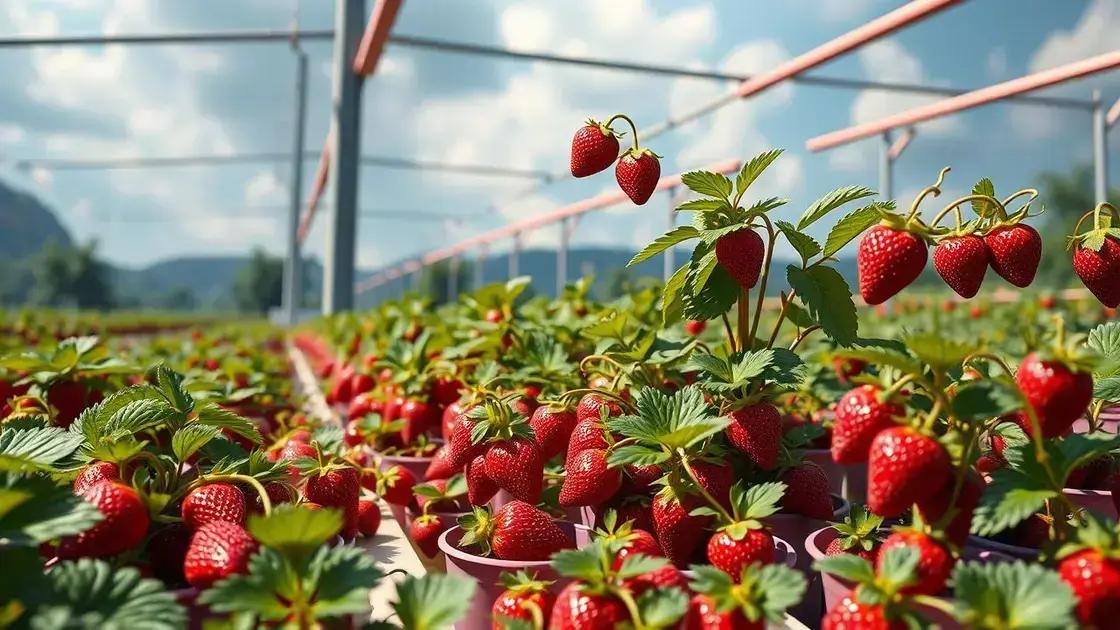How to Care for Strawberry Plants in Containers: 5 Expert Tips
How to care for strawberry plants in containers? It’s a question many gardeners ask when looking to enjoy delicious berries. With a little know-how, you can create the perfect environment even in limited spaces. In this guide, we’ll explore essential tips that make strawberry care straightforward, ensuring fruitful results and tasty harvests.
Table of Contents
ToggleEssential soil requirements for container strawberries
Essential soil requirements for container strawberries are vital for promoting healthy growth and abundant fruit production. The right soil not only provides essential nutrients but also ensures proper drainage and aeration. Here are key factors to consider when choosing soil for your strawberry plants.
Choosing the right soil mix
To maximize your success in growing strawberries, consider blending different components:
- Potting soil: A high-quality commercial potting mix is ideal because it’s designed specifically for container gardening.
- Organic matter: Incorporating compost or well-rotted manure will enrich the soil with nutrients.
- Aeration agents: Mix in perlite or vermiculite to enhance drainage and prevent soil compaction.
Soil pH for strawberries
The optimal pH level for strawberry plants ranges from 5.5 to 6.5. Here are steps to check and adjust pH:
- Use a soil pH test kit to measure current levels.
- If pH is too low, add lime to raise it; if too high, incorporate sulfur to lower it.
- Re-test periodically to maintain the ideal pH range.
Water retention and drainage
Maintaining the right balance of moisture is crucial:
- Drainage holes: Ensure your containers have adequate drainage holes to prevent waterlogged soil, which can lead to root rot.
- Mulch: Apply a layer of organic mulch, like straw or wood chips, to help retain moisture while preventing weeds.
Using fertilizers
Regular fertilization is important for nutrient supply:
Consider using a slow-release fertilizer formulated for strawberries and follow the package instructions for application frequency. Exploring indoor gardening techniques can also provide insights into various fertilizer options suited for different plants.
In summary, using a balanced soil mixture with the correct pH and moisture will help your container strawberries thrive and yield a sweet harvest, ensuring you enjoy the fruits of your labor.
Optimal watering schedule for healthy strawberry growth

Optimal watering schedule for healthy strawberry growth is key to ensuring your plants flourish. Strawberries require consistent moisture to develop strong roots and produce juicy fruit. This guide will help you understand how to effectively water your container strawberries.
Understanding water needs
Strawberries typically need about 1-2 inches of water per week, but this can vary based on factors such as:
- Temperature: Hotter days may necessitate more frequent watering.
- Container size: Larger pots retain moisture longer than smaller ones.
- Soil type: Well-drained soil dries out faster than heavy soil.
Signs of under or overwatering
Monitoring your plants is crucial. Here are some indications:
- Underwatering: Leaves may wilt or turn brown on the edges.
- Overwatering: Yellowing leaves and stale smell from the soil indicate excessive moisture.
Creating a watering schedule
Consistency is important. Consider these steps:
- Check soil moisture by inserting your finger about an inch deep.
- Water when the top inch of soil feels dry.
- Use a watering can or hose with a gentle spray to prevent soil displacement.
Watering techniques
Employ these techniques for efficient watering:
- Drip irrigation: This method delivers water directly to the root zone.
- Soaker hoses: Ideal for containers as they allow slow absorption.
During dry spells, consider supplementing with a moisture retention product or learning exploring indoor gardening techniques to enhance plant health.
Adjusting water practices
Adapt your watering regimen according to the season:
- Spring and summer: Water more frequently as plants grow and fruit begins to form.
- Fall: Gradually reduce watering as temperatures drop.
By following this optimal watering schedule, you will support healthy strawberry growth and enjoy a bountiful harvest. Monitoring your plants and adjusting based on their needs will lead to successful results.
Sunlight exposure tips for thriving container strawberries
Sunlight exposure tips for thriving container strawberries are essential for ensuring your strawberry plants produce bountiful fruit. Strawberries require plenty of sunlight to grow healthy and strong, making it crucial to understand their light requirements.
Optimal sunlight duration
Strawberries thrive best with:
- Full sun: Aim for at least 6-8 hours of direct sunlight each day.
- Location: Choose a spot that is not shaded by trees, buildings, or other structures.
Adjusting for seasons
Sunlight exposure can vary with the seasons:
- Spring: As temperature rises, monitor the plants for adequate sun exposure, adjusting their location if necessary.
- Summer: Provide partial shade during the hottest part of the day to prevent scorching.
- Fall: As days shorten, keep strawberries in areas that receive the most sunlight.
Monitoring light conditions
Keep an eye on your strawberry plants:
- Leaf color: Healthy leaves are bright green. Yellowing may indicate insufficient light.
- Growth patterns: Plants reaching towards sunlight suggest they need more exposure.
Artificial lighting options
Consider using grow lights if natural sunlight is insufficient. When choosing artificial lighting:
- LED grow lights: Energy-efficient and effective for promoting healthy growth.
- Fluorescent lights: A great option for starting seedlings indoors before transferring them outdoors.
For further tips on enhancing indoor gardening, check out exploring indoor gardening techniques.
Container placement
Finally, optimize your container placement:
- Rotate containers periodically to ensure even sunlight exposure.
- Raise containers off the ground slightly to reduce heat absorbed from hot surfaces.
By following these sunlight exposure tips, you’ll help ensure your container strawberries thrive and produce delicious, sweet fruit all summer long.
In conclusion
Caring for strawberry plants in containers requires attention to several key factors, including optimal soil requirements, a consistent watering schedule, and adequate sunlight exposure. By implementing these strategies, you can ensure that your strawberries grow healthy and yield a delicious harvest. Remember, gardening is an ongoing learning experience; don’t hesitate to seek out additional resources for tips and advice. For further tips on enhancing your indoor garden, explore community discussions that can provide valuable insights and support.

